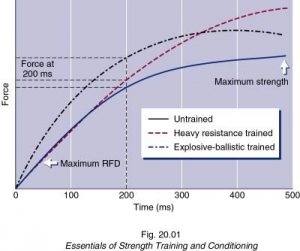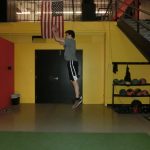Sports Performance Training: Strong Should Not Be Defined Just By The Amount Of Weight You Lift
One of the biggest misconceptions is that strong is strong and fast is fast. I hear it all the time from athletes and coaches I/You just have to get stronger. If the training purpose is for general fitness or powerlifting this might be the case. However, if the purpose is for sports performance you need to look at multiple facets, one being the speed at which the given sport is played which will impact the speed at which you need to execute the training exercise.
Take for instance in an actual game the time it takes for a baseball swing (about 100-120 millisecond, ms) or the time the foot is on the ground when running (80-200 ms) these times need to be taken into account when training because it is in that time frame you are trying to maximize your body’s abilities.
Below is a graph that shows the amount of force ( the weight you are moving) created at given points in time with different training methods. While heavy resistance training will produce the most force in a longer time, that longer time is not within the time many sport tasks happen. So we need to look at the time most sport happens (200 and below) which shows that using explosive-ballistic training creates the greater Rate of Force Development in that time. (1)

Explosive movements require moving an object with as much velocity as possible, often involving the reactive and eccentric components of the muscle and tendon. Ballistic movements are when you propel an object, could be yourself (jumping) or an object (throwing a medicine ball). Heavy resistance training is lifting greater amounts of weight with no care in the velocity, only whether or not you lifted it, which involves more of the cross-sectional area of the muscle.
We are not saying that all training has to be done within that 0-200ms time frame, but the training methods used need to enhance the athlete’s ability to move within that time frame.
There are a couple methods that F2P uses to ensure the speeds our athletes train at are conducive for their sport task. The first is the use of a tendo unit. A tendo unit is a device that will measure actual bar speed and power. Having the ability to measure and track these ensures that the athlete is becoming more explosive in the given exercise. Depending on the phase that a given athlete is in, it will dictate how fast we are looking for the bar to move. This desired speed becomes the variable that decides how much weight to use and when to adjust it. I have found this instant feedback will give the athlete something to challenge themselves to always increase from rep to rep and set to set, increasing and teaching them how to put full intent into their training.
The second method is the use of a 4 jump reactive test which provides us the ability to analyze if the athlete is creating more force in a shorter amount of time. In most cases, we will have the athlete jump using their body as the weight, however, you can add weight if you are trying to track their ability exactly like it happens in their sport (i.e. simulating the weight of pads). Over the four jumps we get the average time spent on the ground and the average jump height of the athlete. The less time and greater jump height the athlete can develop, the greater explosiveness it shows for that given time.
Strong is strong and fast is fast but only for that given time frame. This is a basic principle often overlook in sports performance training. If the desired outcome of training is for sports performance you can’t just train to become bigger, faster, and stronger; you have to become those within the time frame your sport demands.
References:
(1) Plisk, Steven S. Speed, Agility, and Speed- Endurance Development. In: Essentials of Strength Training and Conditioning. R.W. Earle and T.R. Baechle, eds.Champaign, IL Human Kinetics, 471-491, 2000.





